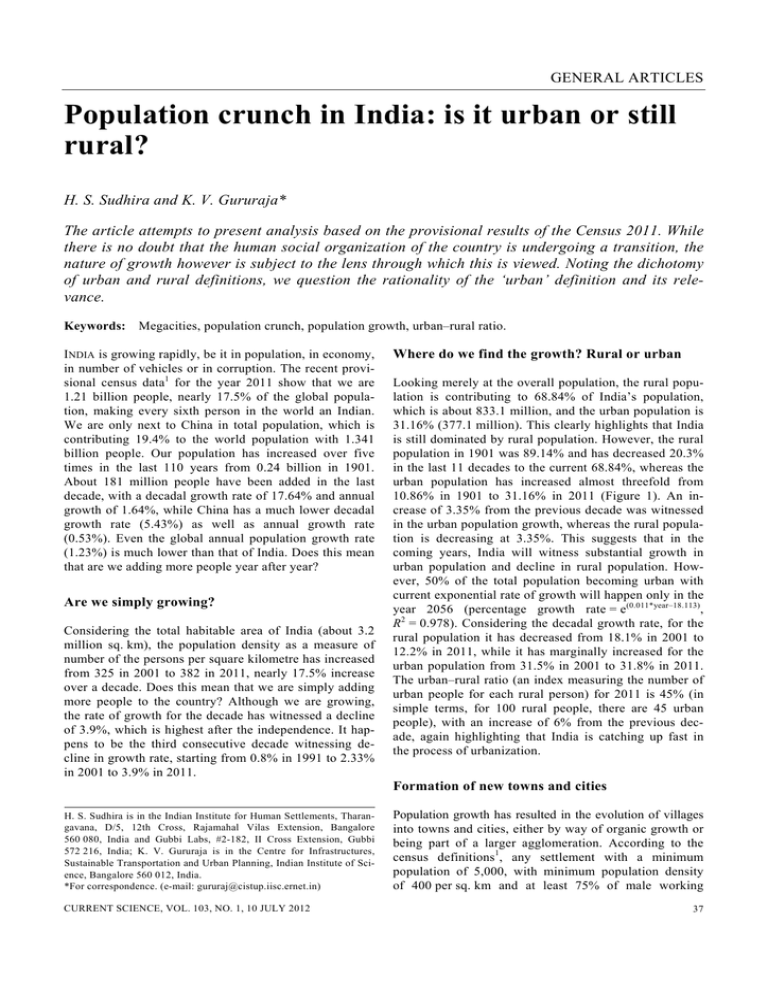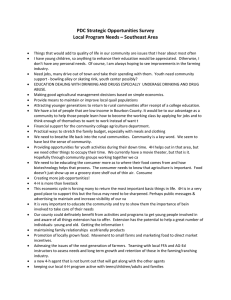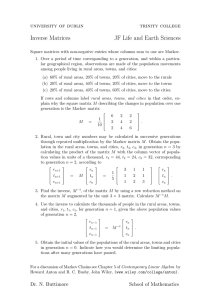Population crunch in India: is it urban or still rural?
advertisement

GENERAL ARTICLES Population crunch in India: is it urban or still rural? H. S. Sudhira and K. V. Gururaja* The article attempts to present analysis based on the provisional results of the Census 2011. While there is no doubt that the human social organization of the country is undergoing a transition, the nature of growth however is subject to the lens through which this is viewed. Noting the dichotomy of urban and rural definitions, we question the rationality of the ‘urban’ definition and its relevance. Keywords: Megacities, population crunch, population growth, urban–rural ratio. INDIA is growing rapidly, be it in population, in economy, in number of vehicles or in corruption. The recent provisional census data1 for the year 2011 show that we are 1.21 billion people, nearly 17.5% of the global population, making every sixth person in the world an Indian. We are only next to China in total population, which is contributing 19.4% to the world population with 1.341 billion people. Our population has increased over five times in the last 110 years from 0.24 billion in 1901. About 181 million people have been added in the last decade, with a decadal growth rate of 17.64% and annual growth of 1.64%, while China has a much lower decadal growth rate (5.43%) as well as annual growth rate (0.53%). Even the global annual population growth rate (1.23%) is much lower than that of India. Does this mean that are we adding more people year after year? Are we simply growing? Considering the total habitable area of India (about 3.2 million sq. km), the population density as a measure of number of the persons per square kilometre has increased from 325 in 2001 to 382 in 2011, nearly 17.5% increase over a decade. Does this mean that we are simply adding more people to the country? Although we are growing, the rate of growth for the decade has witnessed a decline of 3.9%, which is highest after the independence. It happens to be the third consecutive decade witnessing decline in growth rate, starting from 0.8% in 1991 to 2.33% in 2001 to 3.9% in 2011. Where do we find the growth? Rural or urban Looking merely at the overall population, the rural population is contributing to 68.84% of India’s population, which is about 833.1 million, and the urban population is 31.16% (377.1 million). This clearly highlights that India is still dominated by rural population. However, the rural population in 1901 was 89.14% and has decreased 20.3% in the last 11 decades to the current 68.84%, whereas the urban population has increased almost threefold from 10.86% in 1901 to 31.16% in 2011 (Figure 1). An increase of 3.35% from the previous decade was witnessed in the urban population growth, whereas the rural population is decreasing at 3.35%. This suggests that in the coming years, India will witness substantial growth in urban population and decline in rural population. However, 50% of the total population becoming urban with current exponential rate of growth will happen only in the year 2056 (percentage growth rate = e(0.011*year–18.113), R2 = 0.978). Considering the decadal growth rate, for the rural population it has decreased from 18.1% in 2001 to 12.2% in 2011, while it has marginally increased for the urban population from 31.5% in 2001 to 31.8% in 2011. The urban–rural ratio (an index measuring the number of urban people for each rural person) for 2011 is 45% (in simple terms, for 100 rural people, there are 45 urban people), with an increase of 6% from the previous decade, again highlighting that India is catching up fast in the process of urbanization. Formation of new towns and cities H. S. Sudhira is in the Indian Institute for Human Settlements, Tharangavana, D/5, 12th Cross, Rajamahal Vilas Extension, Bangalore 560 080, India and Gubbi Labs, #2-182, II Cross Extension, Gubbi 572 216, India; K. V. Gururaja is in the Centre for Infrastructures, Sustainable Transportation and Urban Planning, Indian Institute of Science, Bangalore 560 012, India. *For correspondence. (e-mail: gururaj@cistup.iisc.ernet.in) CURRENT SCIENCE, VOL. 103, NO. 1, 10 JULY 2012 Population growth has resulted in the evolution of villages into towns and cities, either by way of organic growth or being part of a larger agglomeration. According to the census definitions1, any settlement with a minimum population of 5,000, with minimum population density of 400 per sq. km and at least 75% of male working 37 GENERAL ARTICLES Figure 1. Decadal growth in India’s rural and urban population. population engaged in non-agriculture activities is considered as a town. There were 7,935 towns in 2011 as against 5,161 in 2001. About 13.3% of India’s population and 42.6% of urban population reside in 53 cities having more than a million people, while the remaining 7,882 cities account for 47.4% of the urban population. There has been a steady increase of million-plus cities from 5 in 1951 to 35 in 2001 to 53 in 2011 (Figure 2). Table 1 shows the percentage population holding of million-plus cities since 1951. Though the number of towns and cities may have increased, preliminary analysis suggests an increasing urban primacy. About 31% of the urban population lives in the top-20 cities and about 51% of the country’s urban population lives in the top-100 cities. There are 468 Class I cities (city with at least 1 lakh people) and 264.9 million people live in these cities constituting 70% of the total urban population. ‘Delhi topples Mumbai as the maximum city’ read a Times of India (ToI) article2. Has it already? The Census of India had released the provisional population totals for cities during mid-October 2011, which indeed had a different rank-order. A careful read of the fine-print revealed that ToI has added neighbouring settlements of Noida, Greater Noida, Ghaziabad, Gurgaon and Faridabad to the Delhi Urban Agglomeration (UA) population to arrive at a figure of 21.7 million people. Following a similar approach for Mumbai, ToI has added the population of Vasai–Virar, Panvel, Bhiwandi and Navi Mumbai–Panvel–Raigad to Mumbai UA, resulting in a figure of 20.7 million, which is still a million lesser than Delhi’s new total. A simple arithmetic jugglery by a national daily alters the ranking and shapes the imagination of millions, which is contrary to the census results. Is it really so simple to add/modify the population of neighbouring settlements and change the rank-order? Why did the census then 38 follow this method or how come the census results paint a different picture? The trajectory of population growth for the top-20 cities is depicted in Table 2. As can be seen, Mumbai officially retains the top spot, with Delhi and Kolkata following suit. However, Bangalore has seen some rapid rise beating Hyderabad and approaching the size of Chennai. Interestingly, two cities from Kerala are in the top-20: Kochi and Kozhikode. Cities like Pune and Surat have also registered significant growth rate. Further, some interesting patterns have been emerging from the provisional results. For instance, Kerala has become the fourth most urbanized state (after Goa with 62%; Mizoram with 51.5% and Tamil Nadu with 48.5% urban population), which is now about 48% urban. The number of UAs in Kerala has gone up from 17 to 19 (but of these, some UAs were merged and five new UAs were formed). The number of million-plus UAs in Kerala has increased from 1 to 7. Also, the number of census towns in Kerala has gone up from 99 to 461. Interestingly, the population of Kerala has not increased all that much (about 5%) and the rural population has declined significantly (about 25%). While the census results have a lot to offer – the nuances of defining the city jurisdictions largely influence these interpretations and subsequent comparisons. In the method employed by ToI, neighbouring cities that have been considered span into different states. This leads us to a more pressing question: what is the extent that defines a city? Slowdown in megacities There are three megacities in India having over 10 million people (Greater Mumbai – 18.4 million, Delhi – 16.3 million and Kolkata – 14.1 million). The population growth CURRENT SCIENCE, VOL. 103, NO. 1, 10 JULY 2012 GENERAL ARTICLES Figure 2. tive year. Million-plus cities/urban agglomeration in India from 1951 to 2011. Diameter of the circle is proportional to population in the respec- Table 1. Million-plus cities in India since 1951 and their populations Year City Population (in millions) 1951 1971 1991 2001 2011 5 9 23 35 53 11.75 27.84 70.68 108.72 160.71 Proportion of urban population (%) Proportion of total population (%) 18.83 25.52 32.75 38.00 42.62 3.25 5.08 8.35 10.57 13.28 in these megacities has slowed down considerably (less than half) in the last decade. Greater Mumbai UA, which had witnessed 30.47% growth in population during 1991– 2001, has recorded 12.05% growth during 2001–2011. Similarly Delhi, from 52.24% in 1991–2001 to 26.69% in 2001–2011, and Kolkata, from 19.60% in 1991–2001 to 6.87% in 2001–2011 have also slowed down. A nation in transition? From the above discussions, several questions emerge on the nature of growth in India. Perhaps, we could only CURRENT SCIENCE, VOL. 103, NO. 1, 10 JULY 2012 assert that the nation is experiencing a strange transition subject to the lens through which ‘number crunching’ of official estimates is viewed. For the third consecutive decade, the growth rate is declining, posing a question whether the nation’s population is stabilizing? Although the urban population growth rate is greater than the rural population growth rate, the sheer magnitude of the existing rural population still accounts for 68.84% of the country’s population. While falling agriculture produce and poverty-induced migration from rural to urban areas3–5; has been traditionally ascribed for urban growth, recent studies suggest that organic urban growth is also contributing significantly to the high rates of urbanization6,7 and not rural-to-urban migration alone. A key question that emerges is on the rationality of definition of ‘urban’ and its relevance. The newly added towns (2,774 of them) were the large villages in the last census, but how come the population in these ‘towns’ shifted to non-agriculture activities in a span of 10 years? Ascribing the nature of livelihood (certain proportion of the population in non-agriculture activities) may not be appropriate for several of these ‘new’ towns, as many of these settlements are very much enmeshed with 39 GENERAL ARTICLES Table 2. Rank 1 2 3 4 5 6 7 8 9 10 11 12 13 14 15 16 17 18 19 20 Top-20 most populated cities in India. Population in millions and rank is based on 2011 population data City/urban agglomeration 2011 2001 1991 1971 1951 Mumbai Delhi Kolkata Chennai Bangalore Hyderabad Ahmedabad Pune Surat Jaipur Kanpur Lucknow Nagpur Ghaziabad Indore Coimbatore Kochi Patna Kozhikode Bhopal 18.41 16.31 14.11 8.70 8.50 7.75 6.35 5.05 4.59 3.07 2.92 2.90 2.50 2.36 2.17 2.15 2.12 2.05 2.03 1.88 16.37 12.79 13.22 6.42 5.69 5.53 4.52 3.75 2.81 2.32 2.69 2.27 2.12 12.57 8.38 10.92 5.36 4.09 4.28 3.3 2.49 1.52 1.52 2.11 1.64 1.66 5.97 3.65 7.42 3.17 1.66 1.8 1.75 1.14 2.97 1.44 4.67 1.54 1.64 1.45 1.35 1.71 1.1 1.14 1.14 1.1 1.45 1.06 agriculture and related activities. Besides this, some states (Tamil Nadu, for instance) have taken lead in notifying ‘statutory towns’, which are not necessarily census towns. Given the dichotomy of ‘census’ towns and ‘statutory’ towns, the categorization of ‘urban’ itself is in question. A probable way out is to assert the status linking the population of a given region with land use and their interactions therein. However, it is essential to keep the common man at the centre of any development agenda, and let the debates and/or assessments on how the classification of urban or rural can affect him/her continue. 1. Census of India, Rural–urban distribution. In Provisional Population Totals, Paper 2, 2011, vol. 1, India Series 1, pp. 1–19; http://www.censusindia.gov.in/2011-prov-results/paper2/data_files/ india/paper2_1.pdf, accessed on 21 March 2012. 2. Rukmini, S. and Hemali, C., Delhi topples Mumbai as maximum city. In Times of India, 20 October 2011; http://articles.timesofindia. 40 3. 4. 5. 6. 7. 1.13 1.28 indiatimes.com/2011-10-20/india/30302508_1_delhi-topplesmumbai-urban-population-lives-navi, accessed on 21 March 2012. Mukherji, S., Poverty induced migration and urban involution in ESCAP countries. In Paper presented at UN-ESCAP, Expert Group Meeting on Poverty and Population in ESCAP Region, Bangkok, September 1995. Harris, N., Migration and development. Econ. Political Wkly, 2005, 40, 4591–4595. Dutta, P., Urbanization in India. In Paper Presented at Regional and Sub-Regional Population Dynamic Population Process in Urban Areas European Population Conference, Liverpool, UK, 21–24 June 2006. Sivaramakrishnan, K. C., Kundu, A. and Singh, B. N., Oxford Handbook of Urbanization in India, Oxford University Press, 2005. Indian Institute for Human Settlements, Bangalore, Urban India 2011: Evidence. http://www.iihs.co.in/wp-content/themes/education/ resources/IUC-Book.pdf, accessed on 5 June 2012. Received 16 April 2012; accepted 23 May 2012 CURRENT SCIENCE, VOL. 103, NO. 1, 10 JULY 2012




